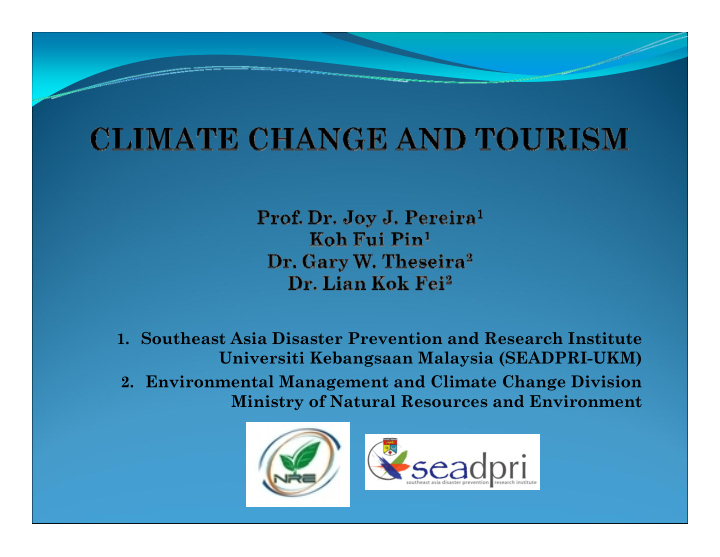



1. Southeast Asia Disaster Prevention and Research Institute Universiti Kebangsaan Malaysia (SEADPRI-UKM) 2. Environmental Management and Climate Change Division Ministry of Natural Resources and Environment
CONTENTS � Introduction – Definitions; Overview � Climate Change & Tourism – Impacts; Implications � Adaptation in the Tourism Sector � Regional Knowledge Gaps � Concluding Remarks
DEFINITION Climate change refers to any change in climate over time, whether due to natural variability or as a result of human activity (IPCC) . Tourism is defined as ‘… the activities of persons traveling to and staying in places outside their usual environment for not more than one consecutive year for leisure, business and other purposes not related to the exercise of an activity remunerated from within the place visited.” (UNWTO/United Nations Recommendations on Tourism Statistics)
AN OVERVIEW CLIMATE A principal resource for tourism. • A principal driver of global seasonality in tourism demand. • A co-determinant to the suitability of locations for a wide range of tourist activities. • An important factor in influencing operating costs. Defines the length and quality of tourism seasons and plays a major role in destination choice and tourist spending. Redistribute climate resources for tourism CLIMATE CHANGE geographically and seasonally and poses a risk to ecosystems worldwide. The response of tourists to the complexity of destination impacts will reshape demand patterns and play a pivotal role in the eventual impacts of climate change on the tourism industry. Source: UNWTO and UNEP, 2008
AN OVERVIEW With its close connections to the environment and climate itself, tourism is considered to be a highly climate-sensitive economic sector similar to agriculture, insurance, energy, and transportation (Wilbanks, T.J. et al., 2007). Particularly concerns CLIMATE CHANGE Developing countries Tourism constitutes IMPACTS and Small Island the major livelihood of local communities Developing States. Positive Negative Requires adaptation by all major tourism stakeholders. Market Geographic The need for awareness and preparedness for natural hazards at segment region the local level through systematic capacity building and strategies for disaster risk management. Source: UNWTO and UNEP, 2008
CLIMATE CHANGE AND TOURISM SECTOR Impacts Implications Climate Tourists response Tourism destinations: Tourism Change to the impacts demand: on destinations. 1. Coastal destinations and small islands 1. Changes in Three primary global factors: 2. Mountain regions and demand 1. Climate winter sports patterns. 2. The natural 3. Nature ‐ based 2.Changes in environment destinations regional ‐ local demand 3. Personal safety 4. Heritage destinations patterns. Source: UNWTO and UNEP, 2008
POTENTIAL IMPACTS & IMPLICATIONS AT TOURISM DESTINATIONS Source: UNWTO & UNEP, 2008
IMPACTS & IMPLICATIONS: MOUNTAIN DESTINATIONS Source: UNWTO & UNEP, 2008 Glacial Retreat in Alaska, USA
IMPACTS & IMPLICATIONS: COASTAL DESTINATIONS Source: UNWTO & UNEP, 2008
ADAPTATION IN THE TOURISM SECTOR Figure 3 Relative adaptative capacity of major tourism sub-sectors. Source: Scott, D. and Jones, B. (2006a)
ADAPTATION IN THE TOURISM SECTOR Climate adaptation options in the ski industry Source: Scott, D. and McBoyle, G. (2006)
ADAPTATION IN THE TOURISM SECTOR Possible adaptation measures for tourism in small island countries and barriers to implementation. Source: Becken, S. and Hay, J. (2007)
ADAPTATION IN THE TOURISM SECTOR Possible adaptation strategies for natural and cultural heritage destinations Source: UNESCO-WHC (2007)
INFORMATION GAPS & HOTSPOTS OF IMPACTS ON TOURISM DESTINATIONS Geographic distribution of major climate change impacts affecting tourism destinations Source: UNWTO and UNEP, 2008
REGIONAL KNOWLEDGE GAPS Relative level of regional knowledge on climate change and tourism (a) (a) Based on independent evaluations of: IPCC (2007(b), Summary for Policymakers; Hall, C.M. (2008-submitted), Tourism and Climate Change: Knowledge Gaps and Issues; and Report of the Authors.
CONCLUDING REMARKS � In an era of global climate change, it will no longer be sufficient to rely on past experience. � Catastrophic and insidious extreme events can occur which is beyond the range of experience of the tourism sector; thus vulnerable areas need to be identified. � The information requirements for effective, anticipatory climate change adaptation will be substantial and therefore adaptation is a critical area for future research. � Consequently, there is a real need for effective communication and partnership between the climate science community and tourism operators at the regional and local scale, particularly with respect to the development of climate change scenarios and the indicators catered toward local tourism decision-making. � Coherent policy strategies are required to balance adaptation and mitigation, so as to allow tourism growth to simultaneously contribute to poverty alleviation and play a major role in achieving the UN MDG.
FOOD FOR THOUGHT… 2099 Coral bleaching, Australia Insurance premium up by 20-80%, Japan In 75 years, snow making becomes unviable 30 years; glaziers disappear in USA 25 years; snow making inevitable Coral bleaching observed Increased insurance premiums Age:40 Age:40 Age:40 Skiing at higher elevations 2000 USA lost 115 of its150 glaziers Citizen Civil Servant. Elected Rep.
REFERENCES Becken, S. and Hay, J. (2007). Tourism and Climate Change – Risks and 1. Opportunities, Channel View Publications, Cleveland. Scott, D. and Jones, B. (2006). Climate Change and Seasonality in Canadian 2. Outdoor Recreation and Tourism – Executive Summary, Report prepared for the Government of Canada Climate Change Action Fund, University of Waterloo, Waterloo, Ontario. Scott, D. and McBoyle, G. (2006). Climate Change Adaptation in the Ski 3. Industry. Mitigation and Adaptation Strategies to Global Change [Electronic]. SpringerLink. United Nations Educational, Scientific and Cultural Organization – World 4. Heritage Centre (2007). Case Studies on Climate Change and World Heritage, UNESCO-WHC, Paris, (Online), available: http://whc.unesco.org/ documents/publi_climatechange.pdf (07-01-2008). UNWTO and UNEP (2008). Climate Change and Tourism – Responding to 5. Global Challenges. World Tourism Organization, Spain. Wilbanks, T. J. et al. (2007). ‘Industry, Settlement and Society’, in M. L. Parry et 6. al. (eds.), Climate Change 2007: Impacts, Adaptation and Vulnerability. Contribution of Working Group II to the Fourth Assessment Report of the IPCC, Cambridge University Press, Cambridge and New York, pp. 357–390.
Thank You Very Much!
Recommend
More recommend